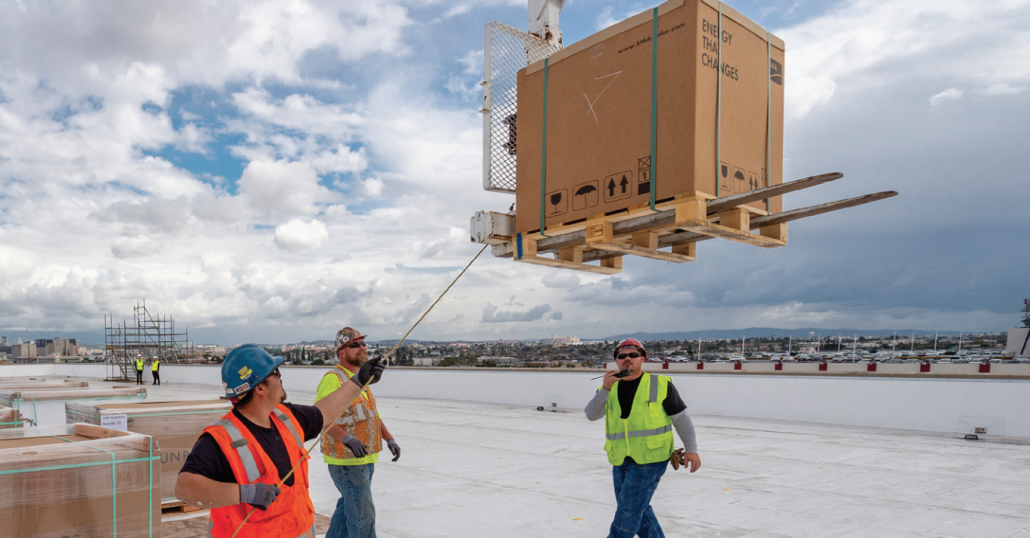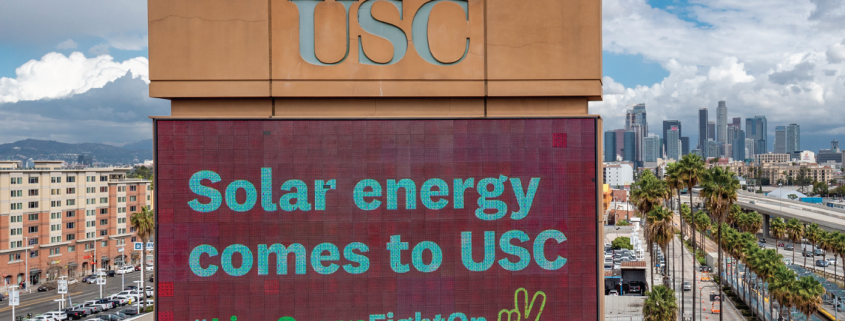University installs solar panels on Galen Center roof

This Saturday the arena will host a “Green Game” featuring compostable and recyclable stations and educational images explaining the importance of sustainability as part of a pilot study to understand the logistical and financial implications of implementing compost and recycling bins at basketball games.
In 2014, students from the Environmental Affairs Organization’s Go Solar Campaign sent a proposal calling on USC administration to install solar panels across campus. In Fall 2015, observing that no administrative action was taking place from the proposal, the group, now known as ECore, continued to advocate for installations by organizing protests and has continued to do so since.
Now, six years later, USC is taking a step in that direction. On Saturday, the University installed solar panels at Galen Center as part of its commitment to being a carbon-free campus. The project is USC’s biggest solar energy project to date and will lead to approximately $10 million in energy savings over 25 years, according to a press release from the University.
The installation was funded by the USC Athletics Department and includes constructing a new roof to install the 1,512 solar modules. Once solar panel installation is complete, Galen Center will rely on up to 15% solar energy, the press release stated.
Galen Center is also adopting other sustainability measures, such as the use of LED lights, placement of compost and recycling bins and installation of a pony chiller — a small machine that cools only the office spaces without using energy to cool the entire arena when games or events are not taking place at Galen Center.
The idea to install solar panels at Galen Center started when the student organization Environmental Affairs Organization, later rebranded as Environmental Core, wrote proposals and petitions for a potential panel installation at Galen Center and submitted the findings including the amount in energy savings the Center would have and solar panels’ purchasing cost to the University in 2014.
According to a previous Daily Trojan article, the organization hosted rallies in 2016 when the University refused to hear from solar consultants and rejected the solar consultants’ proposals. Zachary Manta, who served as ECore director at the time, said when the protests occurred, ECore had expected to work on sustainability efforts with senior administration, but the organization felt ignored since there was little interest in sustainability initiatives at the time.
“Through my junior and senior years, we … felt stonewalled,” Manta said. “Our initiatives and our attempts to go about this cooperatively just weren’t really being received, which is why I had to take a more activist bent and why we started marching down Trousdale and around Tommy Trojan with protest signs.”
According to Office of Sustainability Associate Director Ellen Dux, the initiative has since been revived as an ongoing process by the Office of Sustainability and the USC Sustainability Steering Committee and gained momentum last semester when President Carol Folt arrived and prioritized sustainability.
When Dux heard about the movement to install solar panels at Galen Center, she knew the installation would take time but was necessary to improve energy consumption at USC.
“[The push for sustainability is] just like change everywhere,” Dux said. “[This initiative] starts super slowly, and it seems like it’ll never go anywhere. Then you inch it along, and it picks up speed. More people support it, and then it’s like a downhill snowball — it just rolls and rolls and rolls.”

Dux said Galen Center was a good fit for the solar panels for three reasons. Galen Center passed the rooftop assessment, which checks whether the beams directly underneath the roof can carry the weight of solar panels while also assessing the size of the area. According to Facilities Management Services Energy Manager Zelinda Welch, the indoor arena used 6,906,873 kilowatt-hours and 121,385 therms in the 2019 fiscal year, and the solar panels would help reduce energy usage. Dux also mentioned the visibility of Galen Center within the community.
“[Galen Center] is highly visible to our campus, to our community around us and to people on the freeway,” Dux said. “[The installation of the solar panels] is a great opportunity for folks to visibly see USC’s commitment to sustainability.”
Welch said the installation of solar panels made sense financially because the rebates — refunds for producing and using solar energy — will end soon in Los Angeles. The center wanted to meet the deadline to receive financial benefits for solar energy, Welch said.
Galen Center general manager Paul Neidermire said the solar panel installation, like any other construction project, faced challenges with unpredictable weather.
“The rain in [Saturday’s forecast] was a big deal,” Neidermire said. “All of a sudden, if we weren’t to do the lift today, we would miss a critical marker in our schedule. The project may have gotten behind schedule, and then we’re not hitting our ultimate deadline to get rebates from the city.”
Neidermire said it was also difficult to find a time when Galen Center would be empty to begin the installation because there were only 20 days in the year with no sports games, athletic practices or employees in the building.
In addition to the solar panels, 3,332 new LED lights have been installed at Galen Center, dramatically reducing the amount of wasted energy. The new setup allows the sports lights to be turned off and on instantly instead of waiting 15 to 20 minutes for the switch to work.
This Saturday, the arena will host a “Green Game” featuring compostable and recyclable stations and educational images explaining the importance of sustainability as part of a pilot study to understand the logistical and financial implications of implementing compost and recycling bins at basketball games.
The second lift of solar panels will take place March 21, according to the press release. The solar panels will be fully functioning by mid-June.
“This is kind of a momentous time in a sense,” Welch said. “It’s really how we’re starting to look forward — not just athletics and FMS, but the University. [We’re] really taking this as an opportunity to reframe how we approach sustainability.”

